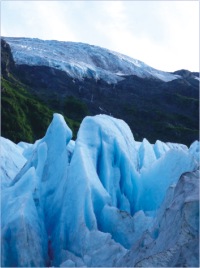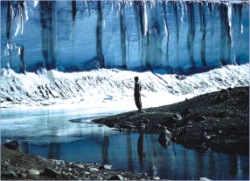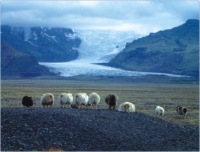 Ice
Shelf Loss Sped Up Glacier Movement
Ice
Shelf Loss Sped Up Glacier Movement
By
Sarah Graham
Two
years ago, Antarctica's Larsen B ice shelf collapsed over the course
of 35 days; 3,250 square kilometers of shelf area--an area larger
than that of Rhode Island--disintegrated. Two new reports have traced
the effects of the collapse on the continent's remaining glaciers
and found that they are flowing ever faster into the surrounding Weddell
Sea.
 "If
anyone was waiting to find out whether Antarctica would respond quickly
to climate warming, I think the answer is yes," says the lead
author of one of the reports, Ted Scambos of the National Snow and
Ice Data Center in Boulder, Colo. "We've seen 150 miles of coastline
change drastically in just 15 years." Scambos and his colleagues
analyzed five images taken by the Landsat 7 satellite before and after
the Larsen B breakup as well as data from ICESat, which measures changes
in elevation. By tracking changes in crevasses on the glaciers' surfaces,
they calculated the speed at which the ice slabs were moving. In the
second report, researchers led by Eric Rignot of NASA's Jet Propulsion
Laboratory used remote sensing and radar data to calculate the glaciers'
movement.
"If
anyone was waiting to find out whether Antarctica would respond quickly
to climate warming, I think the answer is yes," says the lead
author of one of the reports, Ted Scambos of the National Snow and
Ice Data Center in Boulder, Colo. "We've seen 150 miles of coastline
change drastically in just 15 years." Scambos and his colleagues
analyzed five images taken by the Landsat 7 satellite before and after
the Larsen B breakup as well as data from ICESat, which measures changes
in elevation. By tracking changes in crevasses on the glaciers' surfaces,
they calculated the speed at which the ice slabs were moving. In the
second report, researchers led by Eric Rignot of NASA's Jet Propulsion
Laboratory used remote sensing and radar data to calculate the glaciers'
movement.
 The
results suggest that three glaciers--Hektoria, Green and Evans--flowed
eight times faster in 2003 than they did in 2000. Two others, Jorum
and Crane, moved twice as quickly at the beginning of 2003 than in
2000 and nearly three times as fast by the end of the year. In addition,
the findings indicate that glacier elevation dropped by up to 38 meters
in the six months following the collapse.
The
results suggest that three glaciers--Hektoria, Green and Evans--flowed
eight times faster in 2003 than they did in 2000. Two others, Jorum
and Crane, moved twice as quickly at the beginning of 2003 than in
2000 and nearly three times as fast by the end of the year. In addition,
the findings indicate that glacier elevation dropped by up to 38 meters
in the six months following the collapse.
The reports appear
in the current issue of the journal Geophysical Research Letters.
"These two papers clearly illustrate, for the first time, the
relationship between ice shelf collapses caused by climate warming,
and accelerated glacier flow," Rignot remarks.
